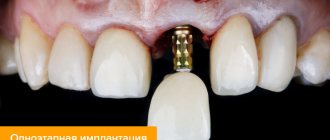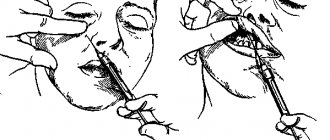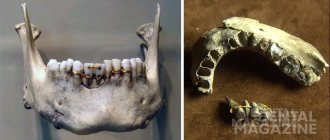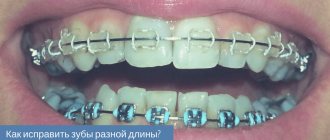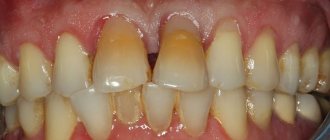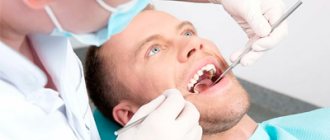Advanced caries, trauma, poor treatment – all these factors are among the most common causes of loss of front teeth. While a person can still come to terms with the absence of a chewing tooth, a hole in the frontal region forces him to immediately seek help from a specialist. Replacement of the anterior group of teeth is a responsible and complex procedure. The doctor faces the difficult task of harmoniously combining three important components - therapeutic, aesthetic and functional. And the best solution to the problem is prosthetics on implants.
Subtleties of implantation of anterior teeth
Anterior tooth implantation has a number of features, since we are talking about the smile zone, an area of increased aesthetic requirements:
- Artificial teeth must be absolutely identical to natural ones (if you are planning an orthopedic system of a lighter shade, you will need to first whiten your teeth).
- The ratio of dental crowns to gums (especially for the upper teeth) is especially carefully taken into account.
- When installing implants, the doctor pays close attention to analyzing the relief of the jaw bone and the thickness of the gums.
- The characteristics of the bite in the frontal zone must be taken into account (some occlusion disorders are an obstacle to implantation.
The main nuances of implanting anterior teeth are related to the fact that the most aesthetic result is expected from a dental prosthetic structure installed in this area, compared to implantation of the chewing group of teeth.
Operation
Medium difficulty
There are contraindications
Doctor's qualifications
High
Choosing an implant for the smile area
The front teeth do not take part in chewing food, so special implants are installed in this area, characterized by maximum aesthetics while preserving the volume of bone tissue, minimal trauma to the gums and a shortened healing period.
Such implants are distinguished by their small diameter, as well as a special thread design and coating that stimulates the process of osteogenesis and osseointegration. To avoid the titanium structure showing through the crown or gum, zirconium structures can be used. A ceramic or zirconium prosthesis for tooth restoration replicates the properties of natural enamel, which ensures complete identity with the rest of the dentition.
Work examples
How often do you visit the dentist?
How to care for what you can eat in the first days after surgery
During the first two weeks, the following recommendations should be followed:
- stop smoking, alcohol;
- exclude hot, spicy foods from the menu;
- You should eat warm, semi-liquid, pureed dishes;
- you need to sleep on a high pillow to prevent a rush of blood to the head;
- eliminate physical activity and stress;
- it is necessary to refrain from air travel and climbing to heights;
- you cannot visit baths, saunas;
- Do not drink through a straw, spit out solutions or saliva;
- During hygiene procedures, avoid the area of sutures.
The next day after surgery, you can perform oral baths using antiseptic solutions, decoctions, and infusions of medicinal herbs.
- Complete restoration of the dentition in just 4 days!
more detailsRoott Pterygoid Implants Sinus lift is no longer needed!
more details
Once and for life! Express implantation in 4 days with a permanent ReSmile prosthesis
more details
All-on-4, All-on-6, ReSmile, Zygomatic implantation We use all modern methods of dentition restoration
more details
Implantation of upper teeth
Implantation of the upper jaw is characterized by certain difficulties associated with the anatomical properties of the bone structures in this area. The upper jaw bears less chewing load, so the bone here is looser and thinner than in the mandible.
- Due to the low height of the alveolar ridge, in some cases, even in the absence of an atrophic process, bone tissue parameters are not enough to install an implant, so surgery is necessary to restore the atrophied vestibular volume of the alveolar process.
- The close location of the maxillary and nasal sinuses makes the maxillary bone even more airy and thin, which increases the risk of perforation of the sinus membrane.
- If the parameters of the maxillary bone in the area of the canines and lateral incisors are limited, an operation to build it up (sinus lift) is performed simultaneously with the implantation of an artificial root.
If there are contraindications to one-stage implantation (narrow ridge, insufficient bone volume, etc.), so that the patient does not walk with a hole in the mouth, instead of a crown, a temporary tooth (retainer) is installed, which is fixed with adhesive material to the adjacent teeth.
Possible side effects
Among the possible complications after the implantation procedure, the main one is rejection of the product. In this case, the latter is removed, and then the specialist must make a decision regarding the rationality of a repeat procedure. In addition, certain adverse reactions may occur:
- Pain that does not stop for several days after the procedure. To get rid of it, painkillers are used. If they do not help, you should seek advice from a specialist.
- Minor bleeding. It should be noted that aspirin should not be used as a pain reliever. This is due to its ability to reduce blood clotting rates. If such situations repeat for more than 10 days, you need to visit an orthopedist.
- Numbness in the area where the product is located. If this feeling does not go away 4-6 hours after the manipulation, this may indicate damage to the nerve endings.
- An inexperienced specialist can harm neighboring teeth or tissues.
- Swelling of the facial area may appear some time after surgery. This is a normal reaction of the body to surgery. As a rule, after 5-7 days the swelling goes away. If this does not happen, the symptoms indicate the beginning of the inflammatory process.
- A slight increase in temperature is caused by the implantation of a foreign body. Optimal values are 37.2−37.5 degrees. Higher values indicate the presence of infection in the body.
Memo to the patient after implantation
Implantation of lower teeth
Loss of bone tissue in the frontal region is observed quite often. Especially if the tooth has been missing for more than 2 years or was lost due to injury. Since the front teeth do not bear large chewing loads, problems with fixation in the bone are solved due to the design features of the implant, allowing in most cases to do without osteoplastic intervention. In the presence of severe atrophy, implantation of the lower anterior teeth, as well as the upper ones, is carried out simultaneously with osteoplasty.
How is implant care related to their service life?
Implantation is one of the few solutions that allows you to make your smile flawless and attractive. In addition, implants ensure the preservation of bone and gum tissue. The bone receives a certain chewing load and does not atrophy, and the gums fit very tightly to the dental crown, which allows you to care for the oral cavity in all the usual ways - regularly use a suitable toothbrush and toothpaste, massage the gums, use an irrigator to clean hard-to-reach interdental spaces. In general, the rules of care are similar to regular oral care. However, it is not recommended to overuse dental floss around implants (only those labeled “super-floss” are allowed); it is better to use an irrigator for this. Proper care is one of the main conditions for a long service life of restorations.
Pros and cons of anterior dental implants
| Advantages | Flaws |
| No grinding or depulpation of adjacent healthy teeth is required | There are contraindications |
| Possibility to place an implant immediately after surgical extraction or tooth loss | It is not always possible to do without osteoplastic surgery |
| Rapid engraftment of artificial root | If the implant fails, the likelihood of success of a repeat operation is greatly reduced. |
| Impeccable aesthetics and full functionality of the dentition | Higher risk of complications than with dental implants |
| Unlimited implant lifespan | It takes time for the implant to take root. |
| Prevention of further loss of the jawbone and gradual restoration of its volume | Rehabilitation period |
| The ability to quickly compensate for both single and multiple dental defects in the frontal zone |
Stages of the procedure
- Diagnostic
Assessment of the volume and general condition of the maxillary bone structures using x-ray diagnostics - orthopantomography and CT with 3D modeling.
- Preparatory
Hygienic cleaning is carried out - all dental deposits are removed, caries and other dental diseases are treated.
- Surgical
The operation is performed under local anesthesia. The operation lasts on average 30-50 minutes; the use of laser equipment significantly reduces the intervention time.
- Orthopedic
After implantation of the implant, an abutment is installed, onto which the adaptive prosthesis is fixed. Permanent dentures are carried out after complete engraftment of the artificial root.
Which clinic to choose
You can get dental implantation in Moscow at one of the ROOTT MCDI clinics. Installation of a two-stage ROOT implant (Switzerland) at the Moscow Center for Dental Implantology will cost 32,000 rubles. (excluding the cost of the crown), express implantation ROOTT – 44,000 rubles. (together with a temporary crown). You can learn more about the implantation technologies used in order to choose the most preferable option and have an idea of what to be prepared for at a free consultation with an implantologist. Appointments can be made by phone or online.
Modern dentistry offers a number of methods that give patients a chance to regain their beautiful smile. Every year, implant treatment becomes more popular and accessible.
In some cases, when it is necessary to remove a patient's own tooth, most often in the case of front teeth, dentists have the option of inserting an implant into the socket immediately after extraction. Then a “temporary” crown can be installed, thanks to which the patient maintains dental aesthetics, speech and chewing function. After about three months, the temporary crown is replaced with a permanent one, made by a technician in a laboratory. Single-stage implants themselves are slightly different in price from those that are loaded with delayed loading.
You can get advice from experienced specialists about dental implantation in the smile zone in the capital’s dental clinics:
| Clinic address | Clinic | Price |
| Dentistry ROOTT |
|
| Moscow, Kolpachny lane, 6, building 4. | Dentistry Sandora |
|
| Dentistry Prosmail.RU |
|
| Moscow, metro station "Butyrskaya", Rustaveli Street, building 15 | Dental Clinic Dention |
|
| Moscow, metro station Barrikadnaya st. Zoologicheskaya, 2, under. 9 | Dentistry DENTAL DREAM |
|
| Moscow, Zvenigorodskoye sh., 7 | Dentistry Implant Expert | Nobel implantation, USA, from 50,000 rubles, Astra Tech implantation, Sweden from 47,200 rubles, OSSTEM Korea - 27,000 rubles |
| Moscow, Bolshoi Sergievsky lane, 5 | Dentistry Viva-dent | Dental implantation depending on complexity: 31,000 - 41,000 rubles per 1 tooth |
| Moscow, st. Molodtsova, 2a | Family discount dentistry | Implantation is carried out using various systems - Astra Tech (Sweden), Ankylos Densply (Germany), Dentium (Korea), the price for 1 restored tooth is from 30,000 rubles. |
| Moscow, Paveletskaya sq., 1 | Dental Clinic Denta VIP | Implantation of the IMPLA system (Germany), OSSTEM (Korea) - from 36,000 rubles. Astra Tech (Sweden) – from 45,000 rubles. |
| Moscow, st. Lyublinskaya, 161 | Dentistry PRESIDENT |
|
Dental implants are the latest technologies that provide exceptional comfort of use. Patients who have lost their front teeth due to an accident, tooth decay, or other diseases can enjoy the ability to function normally and smile without fear, without discomfort, thanks to dental implants. The most modern method of replacing missing teeth is implantation.
Dental implants are placed when we lose our natural teeth. Most often, the decision to replace missing front teeth is made for aesthetic reasons. It's no secret that missing teeth can lead to changes in our appearance, or rather, facial features. You can see the appearance of your cheeks, mouth and nose change. Wrinkles appear faster in the middle part of the face, which makes us feel unattractive.
However, it is worth remembering that from a medical point of view, the replacement of missing teeth, both front and back, is very important. The absence of teeth disrupts the functioning of the chewing system, which over time affects both aesthetics and our health. The absence of molars causes improper grinding of food, which leads to the development of diseases of the digestive system, such as peptic ulcers or increased stomach acidity.
ALTERNATIVE METHODS
If a front tooth is missing along with its root, the patient does not have many options for prosthetics. A single crown requires some kind of support - and if there is no root, only an implant will do. In this case, as an alternative, two more options can be considered: removable and fixed bridges.
Removable and bridge dentures do not put pressure on the bone tissue - as a result, its atrophy continues after the loss of the tooth root. Gradually, the bone sags along with the gum and a gap forms under the prosthesis. This is fraught with a violation of aesthetics and an increased risk of developing inflammatory processes, because plaque and food debris will accumulate under the prosthesis.
Removable prosthetics
When restoring one or more front teeth, a removable denture will be fixed on the gum and cling to the adjacent teeth with special hooks. Modern dentures are made from very soft and comfortable plastics, and the hooks have a translucent pinkish color - exactly like your own gums. However, they will be noticeable in the front zone. In addition, small prostheses are quite poorly attached to the mouth - they should not be considered as a permanent prosthetic option.
Read more about removable dental prosthetics >>>
Bridge prosthetics
A dental bridge is a non-removable type of prosthetics. It has better fixation compared to removable structures; it consists of only crowns without a plastic base, so it achieves better aesthetics. However, the bridge also has disadvantages: it is attached to two adjacent teeth. As a rule, they are healthy, but they need to be turned to a cone shape - the two outermost crowns of the dental bridge will be installed on top.
To make a bridge, only two types of crowns are used - metal-ceramic or zirconium (ceramics are not used, since they may not withstand too much load as part of the bridge). The first crowns have a metal base. If it is made from alloys of inexpensive metals, there is a high risk of gums turning blue, which means loss of aesthetics. If the base is a precious and hypoallergenic metal, the cost of such crowns becomes quite high. In addition, dark metal under the porcelain layer in the area of the front teeth may be visible. Zirconium is a more durable and aesthetic material, but its price is also high. The cost ends up being slightly lower than the price of implantation, but crowns with implants will last longer.
Read more about dental bridges >>>
1 According to statistics provided by the Department of Dentistry of the University of Jerusalem. 2 Paraskevich V.L. Dental implantology. M., MIA. 2006.
Features of implantation of anterior teeth
The success of implantation of anterior teeth consists of: the knowledge and skills of the doctor, choosing the optimal solution together with the patient, a high-quality implant, professional prosthetics of the implant, the condition and amount of bone, the general health of the patient, as well as postoperative procedures - compliance with recommendations during the healing period and impeccable hygiene during throughout the entire period of use. However, despite the fact that many factors influence the final result, the effectiveness of such treatment is very high.
To get a consultation
